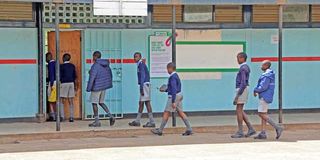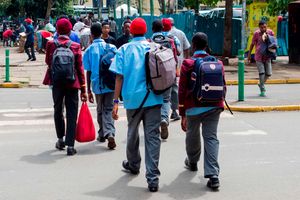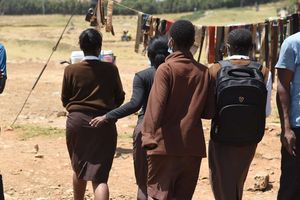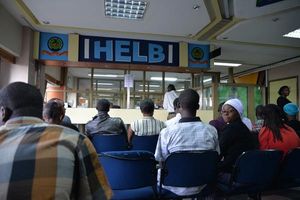
Pupils walk to class at Kileleshwa Primary School in July last year. A Nation spot check revealed the irony of schools that have space but few learners.
Millions of shillings are going to waste as parents and learners shun some public primary and secondary schools as well as universities, in sharp contrast to the over-enrolment and congestion associated with most public institutions of learning.
A spot check by the Nation revealed that public school facilities, equipment and staff that are not being put to optimal use owing to low enrolment. The situation was observed in both urban and rural schools.
Kileleshwa Primary School in Dagoretti North in Nairobi County has the capacity to host about 2,000 learners but only has 200 attending the school. The school is built on a large compound and is well-staffed but has failed to attract enough learners over the years.
“Most of our learners come from as far as Kangemi and Kibra. Parents in the surrounding community prefer to take their children to private schools due to the perception that public education is of a lower standard,” said a teacher at the school who requested anonymity.
Less than three kilometres away, Kilimani Primary School has an enrolment of over 3,000 learners. The same applies for Milimani Primary School along Muringa Road despite it having an even smaller compound.
Also Read: The sham that is Kenya's free education
Nominated Senator Gloria Orwoba has been leading an initiative to transport learners from neighbouring estates like Kawangware where schools are heavily congested. For example, Ndurarua Primary School in the area has over 6,000 learners.
“Transport has been the issue. We have so far transferred about 100 learners to Kileleshwa Primary School,” she said.
Addressing member of the Senate Committee on Education two weeks ago, Basic Education principal secretary Belio Kipsang said that, when the schools were established, it was expected that they would draw learners from the neighbourhood but socio-economic dynamics have since changed.
Along Gen Waruinge Road in Pumwani, Starehe Sub-county, St Brigid’s Primary School appears abandoned. The buildings are dilapidated with broken windows and peeling paint. Inside the classrooms, the furniture is also in a bad state and there is no running water. The public school has an enrolment of about 150 learners despite being in a densely populated low-income estate. It has a large compound typical of schools established decades ago.
“We’ve been ignored by the government and the community. With such low enrolment, the Sh1,420 annual capitation per learner can’t run a school,” a teacher told the Nation.
Next to the school, only separated by a fence, is Pumwani Primary School while up the road is Muslim Primary School and Dr Aggrey Primary School. Further up is Juja Primary School.
“This is a waste of resources. It doesn’t make sense to have all these schools in one place. It’d be better to merge them into one or two and run them efficiently,” said Dominic Njenga, a resident.
Njoroge Mungai, the chief of Kijabe Location, is not a happy man. The source of his sadness is that, in January this year, he witnessed the closure of a school that was dear to him after it failed to attract enough learners. He spoke with nostalgia about Kiambogo Secondary School that is a few kilometres away from Kijabe Hospital in Lari Constituency, Kiambu County.
“I feel the local community played a role to the closure of this school. They had baptised it ‘Kajinga High School’ due to its perennial low grades every time the Kenya Certificate of Secondary Education (KCSE) was announced. In January, it only attracted four admissions in the Form One placement,’’ he told the Nation. The four were from Ruiru and Juja, about 40 kilometres away from the day school.
“The school has all the needed facilities but now with heavy rains, grass has taken over and it is now a bush. It is an institution that, as a community, we lobbied for to survive. I still believe there is hope that one day it will be revived but the local community must change its perception about it,’’ Mr Mungai added.
In the 2023 KCSE examinations, the school had only seven candidates. Mr Mungai declined to comment on their performance. There were no Form Two and Three learners as parents had withdrawn and enrolled them to nearby schools.
The script is the same at St Peter’s Barigitu Secondary School in Gatundu North, also in Kiambu County, that has also closed down after failing to attract enough learners.
“The teachers were the first to be redistributed to other schools. The principal was the last to leave. We consulted the government and unanimously reached a decision to close down the institution because it was not economical to run it when you factor in that it only had 10 candidates who sat for their KCSE exams last year and only five Form Three learners who’d have moved to Form Four. The biggest problem is the local community giving local institutions bad names and they end up becoming big mental issues,” Ms Edith Kariuki, the sub-county director of education, told Nation.
A few kilometres away is Mbici Secondary School that faces imminent closure. It has a total enrolment of less than 60 learners.
“It is a worrying trend that needs to be acted upon,’’ Ms Kariuki added. Serani Secondary School in Mombasa bears a big name but,at the same time, has a sad story of its fall from fame. The school that is famed for its excellence in sports has seen its enrolment shrink and currently has a student population of less than 300.
The principal, Mr Ali Mohammed, who is also a former student at the school, is at pains to explain its predicament. He blames chronic absenteeism for the low enrolment.
“Education is not a priority [here]. Students in Coast region believe they can make it without education. I feel so sad as a teacher and a principal because, during our time, our enrolment was good,” said Mr Mohammed.
Former Mombasa governor Hassan Joho is among the famous alumni of Serani. He left the school in 1993 where he scored a mean grade of D- (minus). Mr Mohammed said that, despite many students excelling in sports, especially football, they have been scoring Ds and Es, which has made parents prefer other secondary schools for their children.
Cheptulel Boys High School in banditry hotspot Chesegon on the border of West Pokot and Elgeyo Marakwet counties remains without learners even after being rehabilitated by the government. The learners were relocated 50 kilometres away to Surumben Primary School in Masol Ward due to insecurity in the region.
The principal of the school, Mr James Koitilo, told the Nation that it previously had a population of over 400 learners.
Also Read: Scourge of private schools in Nairobi slums
“We now have 150 students being hosted at Surumben. We are receiving students and we have 52 Form Ones. Last year, we had only eight. The school opened in March last year before we got hosted temporarily at Surumben,” he says.
The same fate has befallen Sarmach Primary School. The institution, which was set up in the Turkwel area by World Vision in 2012 at a cost of Sh15 million, has less than 200 learners due to insecurity. The deputy headteacher, Mr Justus Orina, said that the school has a capacity to host over 1,000 learners.
The Turkana branch chairperson of the Kenya National Union of Teachers, Mr Kenyaman Eriongoa, said learners avoid enrolling in border schools like Kapedo, Ngilukia and Lomelo.
“Most of these schools have good infrastructure and sufficient teachers but with abnormally low enrolment. The government must beef up security in such areas if they are to attract learners from other villages or towns," he said.
Reporting by David Muchunguh, Simon Ciuri, Winnie Atieno, Sammy Lutta and Oscar Kakai











